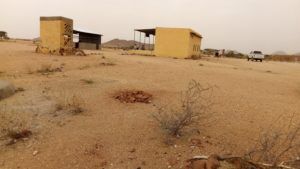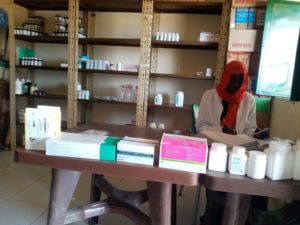 Stories
Stories
July 24, 2020 • 3 min read
The GOAL-supported Abdul Shakur Health Centre in rural North Darfur was operating well, except for one issue. The facility in Kutum locality, where conflict between armed groups was a constant risk, had good staff, medications, and equipment. But it was located near to a military outpost.
This was too close for comfort for many community members, especially women, who had to walk past the outpost to reach the clinic. “We faced difficulties because the health centre was in a military area which was a challenge to both patients and staff,” says mother Aisha , who needed immunization services for her daughter. “Sometimes we would have no access at all.”
The Abdul Shakur Health Centre is one of 17 health facilities in Kutum locality supported by GOAL and the Sudan Humanitarian Fund (SHF). GOAL started working in the area in 2006, operating a mobile clinic during the Darfur conflict. In 2018 GOAL began supporting a fixed site facility, bringing together staff, supplies, equipment, and medications to cater for over 6,000 people from 29 villages.

Picture of the new Abdul Shakur clinic
However, during community engagement sessions by GOAL, members of Abdul Shakur community raised their concerns about challenges they faced in accessing the health facility. People did not want to encounter the military personnel, and therefore didn’t seek out health services. Also, the facility lacked the room to provide all the basic services required.
Late in 2018, after identifying cost savings and exchange gains within its SHF grant, GOAL seized the opportunity to solve both problems at once. It allocated the savings to the construction of a completely new health facility far from the military post, and with five rooms to allow for comprehensive services.
After consulting with the State Ministry of Health, the community and SHF, GOAL built the facility and shifted services to the new site. It now has rooms for consultation, immunization, reproductive health and drugs dispensing room – enough space for privacy in providing all services.
The new health facility had an immediate impact on the community with significant increases in the numbers using the service in 2019 compared to the previous year. For example:
- The annual consultation rates increased by well over 100% from an average of 3,697 to 9,452 visits.
- The ante-natal care (ANC) attendance by pregnant mothers checking on their wellbeing and that of their babies increased 73% from 344 to 596 women.
- Attendance at the Outpatient Treatment Program (OTP) for malnourished children more than doubling with 96 severely malnourished children reached in 2019 compared to 44 children in 2018.
Adam Mustafa, the Medical Assistant in Abdul Shakur, said: “Since this new health facility was constructed, we have seen a significant improvement in the numbers of community members seeking help. For example mothers, their children and other community members seek health services immediately as soon as they have high fever. This has led to a reduction in mortality rates for preventable diseases.”
There is also more community health and behavior change work based out of the facility. In order to address the underlying causes of malnutrition, GOAL with SHF support is facilitating four “Nutrition Impact and Positive Practice” (NIPP) circles in the surrounding villages of Abdul Shakur, engaging 29 women and 30 men with moderately malnourished children to use simple, locally-available methods and foods to treat and prevent malnutrition. In addition, two care groups have been established in the community around the health facility, benefitting a total of 329 people.
Said Aisha: “Now we feel free to come to the clinic any time of day. The medical assistant lives near the health facility, so we also have access at night in case of emergencies. We are grateful to GOAL and SHF for having constructed this facility.”
